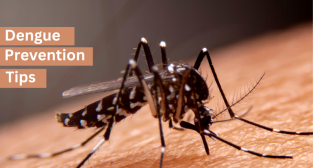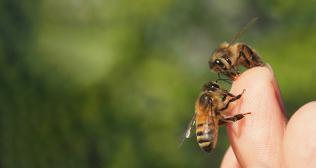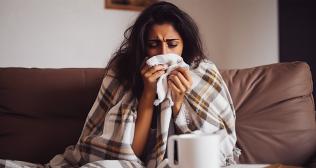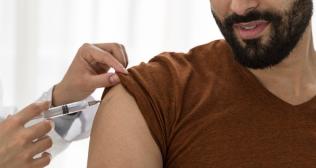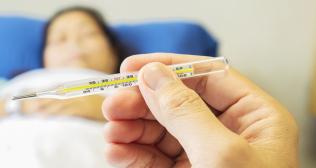
Dengue Fever in Children: Know its Symptoms, Treatment and Prevention
Dengue is a viral infection caused by mosquito bites, belonging to Aedes species, that carry either of the dengue virus type 1, 2, 3, and 4. Globally, about 400 million individuals are affected by the dengue virus, with approximately 40,000 lives lost due to its severity. In recent years, several states in India have also witnessed a concerning increase in dengue cases.
Elevated body temperature and sudden platelet drop indicate dengue, with varying symptoms and severity between adults and children. Dengue is associated with prolonged 10 to 14-day illness creating parental concern when their child is affected by it.
Explore information on dengue in children and preventive measures to avoid it.
Transmission of Dengue
Dengue is transmitted by the bite of infected female Aedes aegypti mosquito, that are active during early morning and late afternoon. When an infected person is bitten by a non-infected mosquito, the virus is transmitted to that mosquito, which then multiplies and further spreads the infection.
How does your child get trap with dengue?
Despite providing children with nutritious meals and maintaining hygiene, their immune systems are still developing, rendering them more susceptible to infection.
Symptoms of dengue in children
The symptoms typically emerge 4-10 days post infection, majority experience mild symptoms during dengue and recover within 1-2 weeks. Some of these symptoms include elevated fever (104°F/40°C), severe headache, pain behind the eyes, nausea, vomiting, muscle and joint pains, swollen glands and rashes.
In case of severity the symptoms include severe abdominal pain, persistent vomiting, fast breathing, bleeding gums or nose, fatigue, restlessness, blood in vomit or stool, feeling thirsty and tired, pale and cold skin. To avoid the development of severe symptoms, seeking care at the onset of early symptoms is strongly recommended.
Diagnosis of dengue
The symptoms of dengue can be alike to malaria and chikungunya. To rule out this health care provider will check for travel history and advise certain laboratory test.
Molecular testing: A positive PCR result confirms the diagnosis, while a negative result may indicate no infection or low level of virus to detect.
Antibody testing: The report of test includes positive or negative by determining the presence of antibodies. Positive IgM and IgG antibodies indicate the diagnosis of dengue infection.
Complete blood count: This test involves analysing the levels of various blood components to assess the severity. Low platelet and total leucocyte count, along with the evidence of anaemia may suggest severe dengue fever.
Can dengue fever be contracted again after it has been diagnosed before?
Yes, according to the World Health Organization, individuals facing a second occurrence are at an elevated risk of severe dengue. Given that the dengue virus consists of four serotypes, an initial infection with one serotype does not confer cross-protective immunity against exposure to another serotype. Subsequent infections, therefore, may involve a different serotype, potentially causing it to be more severe.
Treatment of dengue
There is no definite treatment for dengue infection. Depending on the severity the treatment varies.
- For mild cases, increase in ample fluid intake and sufficient rest followed by any pain killer is recommended for relieving headaches and pain caused by dengue fever.
If your child exhibits any signs of severe dengue, seek immediate medical attention.
- In severe dengue cases, hospital treatment involves IV fluids and electrolytes to replace losses from vomiting or diarrhea. Early intervention is typically effective to avoid further complications.
Prevention of dengue
The most effective means of preventing dengue is to avoid mosquito bites. In all cases of dengue infection, it is crucial to prevent the infected person from getting bitten which limits the spread of the illness to others.
Currently, the Dengvaxia vaccine is accessible for individuals who have experienced dengue at least once and reside in regions where the disease is prevalent, but it is not commonly available. Hence here some of the measures that one can follow to keep yourself and your children to prevent from getting dengue.
- Create a protective barrier with a properly fitted mosquito net or screens over the baby's crib, stroller, or play area.
- Dress your child in long sleeves, long pants, socks, and use recommended age-appropriate mosquito repellent derived from natural sources such as neem and eucalyptus.
- Minimizing mosquito breeding sites in the vicinity of your home, workplace, and educational institutions.
- Stay informed about the prevalence of dengue infection in your vicinity and adhere to health authorities' guidelines accordingly.
- Eliminate water-holding items like bottles, tires, and containers around your home, workplace, or school.
- Clear blocked drains and gutters to avoid water accumulation.
- Secure water storage containers with tight lids or screens to prevent mosquito breeding.
- Encourage neighbours to eliminate breeding sites and protect themselves from mosquito bites.







